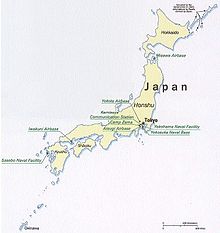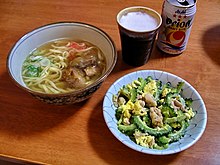Longevity in Okinawa
Okinawa had the longest life expectancy in all prefectures of Japan for almost 30 years prior to 2000.[1] The relative life expectancy of Okinawans has since declined, due to many factors including westernization.[2] In fact, in 2000 Okinawa dropped in its ranking for longevity advantage for men to 26th out of 47 within the prefectures of Japan.
Japan has the highest life expectancy of any country: 90 for women and for men, 84.[3] Compare this to the USA where the average life expectancy for women is 81 years old, and 76 for men.
There are more than 400 centenarians in Okinawa.[4] Although there are a myriad of factors that could account for differences in life expectancy, cuisine could be the largest factor. People from all around the world have tried to emulate the "Okinawa diet" to reap its health benefits,[5] believed to be because it is nutritionally dense yet low in calories.
Diet[edit]
Okinawan cuisine consists of smaller meal portions of green and yellow vegetables, fish, relativity smaller amounts of rice compared to mainland Japan, as well as pork, soy and other legumes. Pork and fish are often served in broth with a variety of ingredients and herbs.[6] The center of the Okinawa diet is the Satsuma sweet potato. The sweet potato provides a large source of energy while keeping calories low. The sweet potato also contributes the self-sufficiency of the island. Contrary to the regular potato, the Okinawa sweet potato does not have a large effect on blood sugar. Not only is the potato used but so are the leaves from the plant. The leaves are used often in miso soup. The Okinawan bitter melon is proven to have some anti-diabetic effects. In Okinawa the bitter melon is called goyain and is served in the national dish, goya champuru. The bitter melon is effective in regulating blood sugar similar to the sweet potato.[3]
Another low-calorie staple in Okinawa is seaweed, particularly, knobu or kombu.[3] This plant, like much of the greenery from the island, is rich in protein, amino acids and minerals such as iodine. Another seaweed commonly eaten is wakame. Like knobu, wakame is rich in minerals like iodine, magnesium and calcium. Seaweed and tofu in one form or other are eaten on a daily basis.[6] According to gerontologist Kazuhiko Taira, the most common cooking fat used traditionally in Okanawa is a monounsaturated fat-lard. Although often called a “saturated fat,” lard is 50 percent monounsaturated fat (including small amounts of health-producing antimicrobial palmitoleic acid), 40 percent saturated fat and 10 percent polyunsaturated. Taira also reports that healthy and vigorous Okinawans eat 100 grams each of pork and fish each day. [7]
Turmeric is prevalent in the Okinawan diet. It has been noted throughout history, especially in South Asia for its health benefits. The Okinawan use turmeric as a spice and also as tea.[3] Turmeric, like many herbs, poses antioxidant properties and anti-aging properties. Moreover, turmeric has a correlation to mental health and dementia. Consumers are less likely to develop mental health illness in later age.[3][8] (However, there are no double blind, randomized, placebo controlled, peer reviewed studies showing that consumers of turmeric or any other herb are less likely to develop mental illness at any stage of life.)
Overall, the diet leads to many benefits seen among people of Okinawa. These include little weight gain with age, low BMI throughout life, and low risk from age related disease.[9] Not only is the diet healthy in preventing disease, many of the foodstuffs contain combative ingredients as well. As mentioned earlier the diet is rich in ingredients that supposedly possess anti-aging and antioxidant properties. However, no ingredients or foods of any kind have ever been scientifically shown to possess anti-aging properties. Research using 100 items from the Okinawa diet shows that some of the diet contains anti-obesity properties or "anti-obese activity".[10]
Research[edit]
Caloric restriction (CR) or dietary restriction (DR) are helpful tools in understanding age and diet related health complications. In the 1972 Japan National Nutrition Survey it was determined that Okinawan adults consumed 83% of what Japanese adults did and that Okinawan children consumed 62% of what Japanese children consumed.[9] It should be noted that today the difference in life expectancy between Okinawan and mainland Japanese is decreasing as the Okinawan are losing their dietary advantage. Recently, there is a decreasing trend in the life expectancy in Okinawa. This is evidenced by low birth weight, poor lactation, and the fact that the life expectancy for Okinawan men is lower than the national average. Scientist such as Dr. Éric Le Bourg believe that the Okinawa diet has more of a deleterious effect then beneficial one. Le Bourg and others alike think that the low protein intake can cause harmful effects on a human as they have done in animal studies. The individuals with a lower protein consumption were more vulnerable to pathogens. Another plausible reason for the decrease in life expectancy is westernization. After World War II, Okinawans started to consume more calories. This in part is due to Americanization of the diet, such as with fast food.[2]
Culture and customs[edit]
Okinawa and Japan have food-centered cultures. Festivities often include food or are food-based. Moreover, the food in Japan tends to be seasonal, fresh and raw. Portion sizes are small and meals are brought out in stages that starts with an appetizers, many main courses including sashimi (raw fish) and suimono (soup), sweets and tea.[11] Since food culture is linked to ancestral traditions, the food culture and presentation is preserved, passing low-calorie food from generation to generation. A belief still prevalent in Okinawa is the healing power of food. Food is regarded as medicine which helps contribute to the longevity of Okinawa.[6] The concept of "food is medicine" came to the island from China.


No comments:
Post a Comment